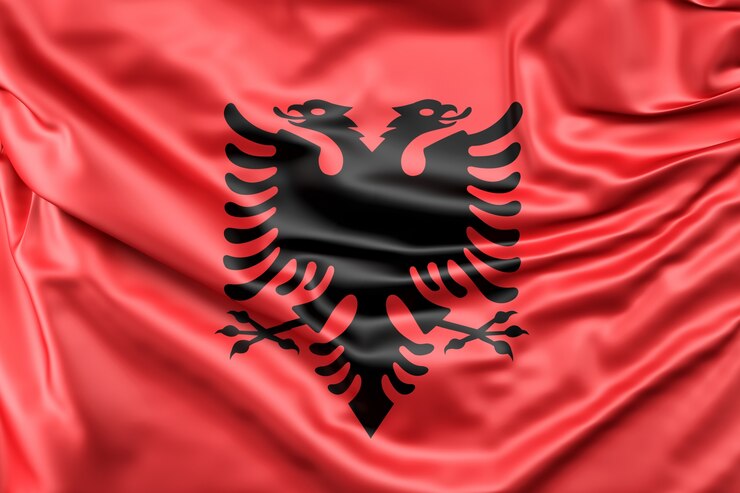The Shqiperia flag, also known as the flag of Albania, stands as a proud symbol of the country’s rich history, culture, and national identity. Featuring a striking design, the flag embodies the resilience, sovereignty, and the enduring spirit of the Albanian people. In this article, we’ll explore the significance of the Shqiperia flag, its history, and how it continues to represent Albania on the global stage today.
What is the Shqiperia Flag?
The Shqiperia flag consists of a red field with a black, double-headed eagle at its center. This iconic design has made the flag one of the most recognizable national symbols in the world. The double-headed eagle has deep historical and cultural ties to Albania, representing strength, independence, and unity. But beyond the design, the colors and symbolism have a far-reaching significance that connects to the nation’s ancient past.
History of the Shqiperia Flag
The origins of the Shqiperia flag are deeply rooted in Albanian history. While the current flag design was adopted officially in 1992, its symbolism goes back to the 12th century. The double-headed eagle has been associated with various empires and dynasties in the Balkans, particularly the Byzantine Empire and later, the Kingdom of Albania.
The Byzantine Empire Influence
The double-headed eagle was first used in ancient Greece and later adopted by the Byzantine Empire, which ruled over a vast part of the Balkans. For Albanians, the eagle was not only a symbol of power and dominion but also a representation of their aspirations for sovereignty.
Skanderbeg’s Role
One of the most significant figures in Albanian history, George Kastrioti Skanderbeg, also played a crucial role in popularizing the flag’s symbolism. Skanderbeg, a 15th-century national hero, used the same double-headed eagle emblem during his battles against the Ottoman Empire. His efforts to unite the Albanian people under this banner remain a key moment in Albanian history, which continues to resonate with Albanians today.
The Modern Flag
The modern form of the Shqiperia flag was adopted on November 28, 1912, after Albania declared its independence from the Ottoman Empire. This flag featured the black, double-headed eagle on a red field, which has remained unchanged ever since, making it one of the few flags in Europe with such a long-standing design.
Symbolism Behind the Shqiperia Flag
The Shqiperia flag is more than just a national emblem; it’s a representation of the values, history, and traditions that shape Albania today. Let’s break down the key elements:
The Double-Headed Eagle
The black, double-headed eagle is the centerpiece of the flag. This eagle has symbolic importance, both in the context of the flag and throughout Albanian culture. The double heads of the eagle represent the unity of the Albanian people, divided across several modern-day countries such as Albania, Kosovo, and parts of Montenegro, North Macedonia, and Greece. It also symbolizes the duality of Albania’s cultural heritage—one foot rooted in the Eastern Byzantine Empire and the other in the Western Latin traditions.
The eagle is also a symbol of power, freedom, and vigilance, representing the watchful eye of Albania over its people and its lands. Historically, it signifies protection from foreign invaders and a reminder of Albania’s longstanding quest for independence.
The Red Background
The red color on the Shqiperia flag carries significant weight. Traditionally, red symbolizes courage, valor, and sacrifice, all of which resonate deeply with the history of Albania, particularly during the 20th century when Albanians fought for their independence. The color also reflects the bloodshed and struggle endured by Albanians in their pursuit of self-determination.
Additionally, the red color is often associated with warmth and strength, two qualities that have been inherent in the Albanian people for centuries.
The Flag’s Evolution Over Time
Pre-Independence Flags
Before the official adoption of the Shqiperia flag in 1912, various regional and historical flags were used. The flags that existed before Albania’s independence often featured emblems related to the regional autonomy of different tribes or cities. These earlier flags were diverse and represented the fragmented political landscape of the time.
The Flag During Communism
During the Communist era (1946-1991), Albania maintained the same design for its flag but introduced additional symbols to reflect the political regime. The original flag’s eagle was often accompanied by images such as a red star or tools of labor, symbolizing the state’s communist ideals.
Post-Communist Albania
When Albania transitioned to a democratic system in the early 1990s, the flag reverted to its original form, shedding the communist-era symbols. In 1992, Albania officially restored the traditional black eagle on a red field, reaffirming its sovereignty and independence while honoring its deep cultural heritage.
The Shqiperia Flag Today: Representation and Recognition
The Shqiperia flag is not just a symbol for the Albanian people but also serves as an important representation on the world stage. It is used in international diplomacy, displayed at major events, and seen at sporting competitions where Albania competes, such as the Olympic Games, the FIFA World Cup qualifiers, and European sporting events.
National Identity
Today, the flag of Albania is a source of pride for Albanians worldwide. It connects the people to their heritage and history, and it’s an essential part of national celebrations, including Independence Day on November 28, which marks the day Albania declared its sovereignty in 1912. The flag is displayed across the country during public holidays, festivals, and government ceremonies, reaffirming Albania’s pride in its independence and cultural identity.
The Flag and Albanian Diaspora
With a significant Albanian diaspora living in countries like the United States, Italy, and Germany, the Shqiperia flag holds special importance. It unites Albanians abroad, who often take pride in showcasing the flag in public spaces and during cultural events. This global display of the flag highlights the widespread influence of Albania and the enduring connection of the Albanian people to their homeland.
Comparing the Shqiperia Flag to Other National Flags
To truly understand the significance of the Shqiperia flag, it helps to compare it to the flags of other nations in the Balkans and Europe. Below is a comparison chart highlighting the key differences and similarities between the Albanian flag and other prominent national flags:
| Country | Flag Description | Key Symbols |
| Albania | Red background with a black, double-headed eagle in the center | Double-headed eagle, red background, symbolizing unity, power, and independence |
| Serbia | Red, blue, and white with a cross and a double-headed eagle | Double-headed eagle, Serbian national colors |
| Kosovo | Blue background with a map of Kosovo and six stars | Map of Kosovo, six stars representing ethnic groups |
| Montenegro | Red background with a golden lion and a crown | Lion, crown, symbolizing sovereignty and heritage |
| North Macedonia | Red and yellow with a sun in the center | Sun, representing hope and unity |
The similarity between the Shqiperia flag and the flag of Serbia, in particular, lies in the use of the double-headed eagle. However, Albania’s version stands out with its bold simplicity—just the red background and the stark black eagle—emphasizing a more direct, raw connection to national pride and history.
The Flag’s Role in Modern Albania
In modern Albania, the Shqiperia flag is not only a historical symbol but a statement of Albania’s continued development and global presence. From political discourse to cultural events and sporting achievements, the flag plays an integral role in showcasing the nation’s growth, pride, and unbreakable spirit.
Albania in International Politics
On the global stage, Albania uses its flag to represent itself in various diplomatic forums, including the United Nations, the European Union, and NATO. Albania’s involvement in international organizations has strengthened its global presence, and the Shqiperia flag continues to serve as a powerful visual reminder of the nation’s resilience and commitment to progress.
Cultural Events and Festivals
The flag also plays a central role in the cultural and traditional festivals in Albania. During events like the Gjirokastër National Folklore Festival, which celebrates Albanian music, dance, and crafts, the flag is often prominently displayed as a reminder of the nation’s rich cultural legacy.
Conclusion: A Lasting Symbol of Pride and Unity
The Shqiperia flag stands as a proud emblem of Albania’s past, present, and future. With its bold design and deep symbolism, it represents the nation’s centuries-long fight for independence, unity, and strength. Whether it’s seen flying high at international events, government buildings, or in the homes of Albanians around the world, the flag serves as a reminder of the enduring spirit of the Albanian people. It is a symbol that transcends borders, connecting Albanians everywhere to their cultural heritage and national identity.
By understanding the history and symbolism of the Shqiperia flag, we gain a deeper appreciation for Albania’s place in the world and the significance of its national emblem. This flag, once seen as a symbol of struggle, is now a beacon of hope, unity, and pride for the Albanian people.







